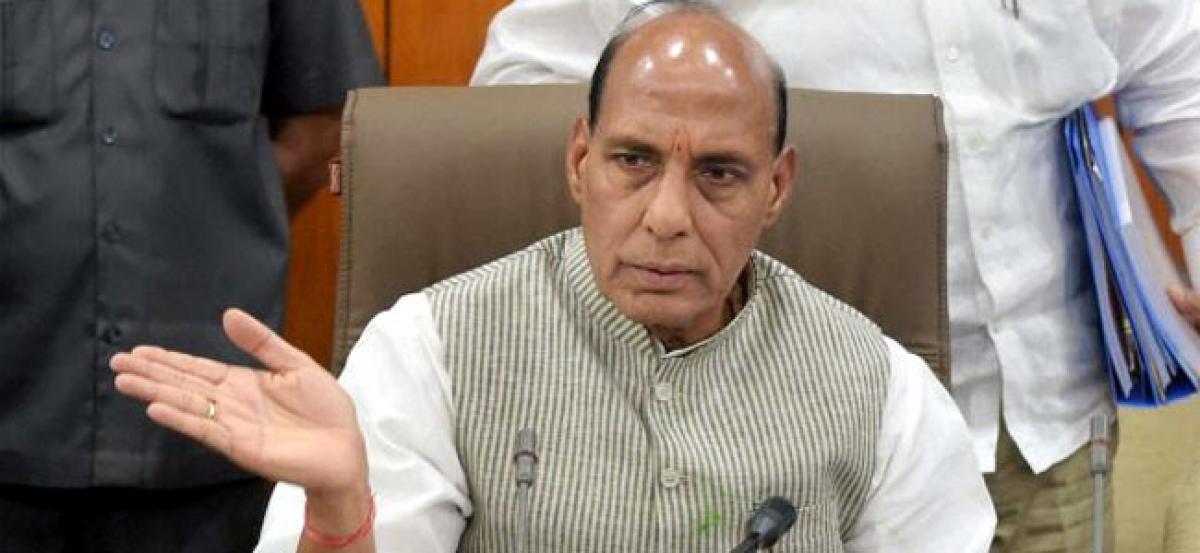Live
- Dharani portal services paused till Dec 16
- Komuravelli Mallanna Swamy Jatara from Jan 19
- Study tour for TG legislators soon
- State cabinet expansion by Dec 31: Ponguleti
- 2 Narayanites bag gold medals in IJSO-2024
- Jail superintendent suspended in ailing farmer handcuff incident
- CM Revanth orders probe into farmer’s handcuff incident
- Handcuffing of farmer after heart stroke draws BRS’ ire
- Jagga Reddy questions unilateral decisions of AICC in-charges in TG
- Tribal women to get trained in multiple skills
Just In

Home Minister Rajnath Singh on Monday described India as one of the most disaster-prone nations, saying more than 50% population of the country lives in areas that are vulnerable to calamities.
Home Minister Rajnath Singh on Monday described India as one of the most disaster-prone nations, saying more than 50% population of the country lives in areas that are vulnerable to calamities.
Singh said the National Platform for Disaster Risk Reduction has been set up by the government to finalise a national strategy to deal with all kinds of disasters in coordination with state governments and other stakeholders.
"India is one of the most disaster-prone nations in the world. More than 50% population in the country lives in areas which are prone to earthquakes, floods, cyclones, droughts and tsunami," he said while inaugurating a meeting organised by the National Disaster Management Authority.
The meeting was attended by ministers from state governments, officials of the state disaster management authorities, top civil and police officials dealing with various disasters and representatives of non-government organisations.
Singh said the national platform was set up so that it can work effectively for disaster risk mitigation along with various stakeholders.
The home minister said India has learnt lessons from the 1999 super cyclone in Odisha where 10,000 people had lost their lives, the 2001 earthquake in Gujarat and the 2004 tsunami and brought a paradigm change in its approach towards disaster risk mitigation.
"We have been working in a planned manner for disaster risk mitigation that include adopting the Disaster Management Act in 2005, disaster management policy in 2009, raising national disaster response force besides others," he said.
Singh highlighted the government's efforts in setting up the early warning system for disasters, cyclone shelters, saline embankments, disaster response force in central and state levels, community preparedness and capacity building.
The home minister said India has become the first country to prepare a livestock disaster management plan for the safety of livestock during a disaster.
Singh also said India has taken a number of steps for enhancing cooperation with South Asian countries in disaster risk mitigation besides improving ties with BRICS, BIMSTEC and East Asian nations. He also asked the participants to prepare a special action plan for vulnerable communities.
In his address, Minister of State for Home Kiren Rijiju said India could not afford to ignore preparing for disasters as it was one of the most disaster-prone nations.
"We are bound to face disasters, not only natural but man-made too. If we can prepare for the disasters properly, we can have a safe and secured society," he said. Rijiju also said India has been taking the lead role in the entire efforts of disaster risk mitigation, especially in South Asia.
In the meeting, the NDMA released the main features of the national database for emergency management. They are disaster dashboard, incident reporting, data visualisation, decision support tools, interaction tools, resource management, India disaster resource network database, mobile apps and data inventory.

© 2024 Hyderabad Media House Limited/The Hans India. All rights reserved. Powered by hocalwire.com







